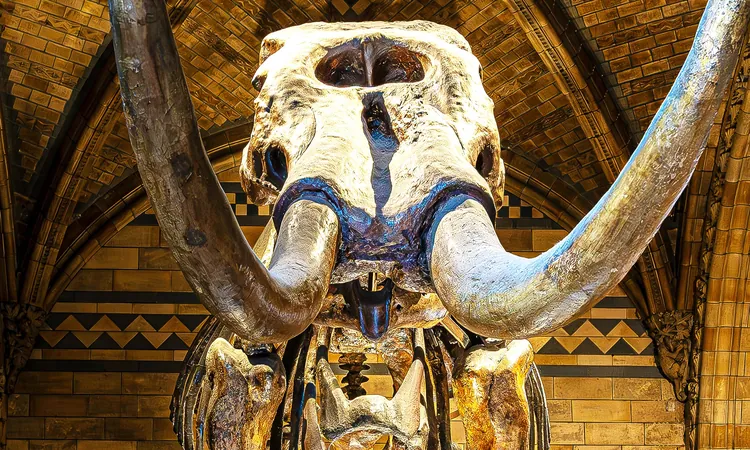
Unveiling the Past: Early Humans and Their Giant Co-Habitants in America
2024-12-24
Author: Ling
Unveiling the Past: Early Humans and Their Giant Co-Habitants in America
Recent research has shed new light on the relationship between early humans and the monumental creatures that inhabited prehistoric America, including massive sloths that weighed more than 8,000 pounds and aggressive mastodons. While modern sloths are famously slow and tree-dwelling, their ancient relatives were colossal giants that roamed the landscape alongside our ancestors.
For many years, the prevailing theory suggested that humans arrived in the Americas around 13,000 years ago and quickly contributed to the extinction of these giants—a phenomenon known as the "Pleistocene overkill" hypothesis. This idea portrayed a scenario of rapid extinction driven by hunting pressure. However, recent archaeological findings are challenging this narrative, suggesting a much earlier arrival of humans and a prolonged period of coexistence with these extraordinary animals.
Rethinking Human Arrival in the Americas
Archaeologist Daniel Odess from White Sands National Park in New Mexico has been at the forefront of this reevaluation. His research team has uncovered evidence, including ancient footprints discovered alongside those of mammoths and giant ground sloths, indicating human presence in North America dating back over 20,000 years. These tracks highlight a remarkable adaptation, suggesting that humans lived within this challenging ecosystem for thousands of years rather than hastily exterminating its megafauna.
The Significance of Sloth Fossils
A particularly fascinating discovery has emerged from the Santa Elina archaeological site in central Brazil, where researchers have found giant ground sloth fossils exhibiting signs of human modification. These bones display small holes and polished edges, indicating they may have been intentionally shaped for use as jewelry or ornamentation by ancient peoples.
The origin of this jewelry has ignited debates: did it come from freshly killed animals or ancient fossils? Initial laboratory analyses suggest these alterations occurred not long after the animals' deaths, proposing the presence of humans in South America as far back as 25,000 years ago. Some sloth bones showed evidence of having been burned, prompting further investigation into their use and the context of their discoveries.
A Complex Picture of Coexistence
The realization that humans might have lived alongside Ice Age megafauna for millennia alters the understanding of prehistoric interactions. Recent findings from other sites like Monte Verde in Chile, which showed stone tools from around 14,500 years ago, and Uruguay’s Arroyo del Vizcaíno, where animal bones with potential cut marks may date back 30,000 years, add to this intriguing narrative. Yet, skepticism persists regarding the accuracy of dating methods and interpretations of findings, prompting ongoing discussion and further investigation.
Environmental Factors in Extinction
If humans didn't drive these creatures to extinction immediately, what factors contributed to their disappearance? Researchers are now proposing that climate change played a significant role. The end of the Ice Age led to shifts in habitats, affecting food and water supplies for both the large herbivores and their predators, including early humans. As climate conditions evolved, the ecosystems that support these majestic animals altered dramatically.
A Richer Understanding of Prehistoric Life
Emerging evidence, including hearth remains indicative of early human campsites, paints a vivid picture of life among Ice Age giants, where humans navigated a complex landscape filled with diverse megafauna. Although the rapid extinction model has dominated for decades, growing evidence suggests nuanced interactions—a long-term coexistence that reshaped not just the inhabitants of North America, but the very course of evolutionary history.
As researchers continue to analyze and reassess these ancient timelines through advanced dating techniques, the narrative of humanity's origins in the Americas becomes ever more layered and intriguing. Each new fossil and artifact adds to the growing puzzle of our past, enriching our understanding of the intricate relationships among early humans, giant sloths, mastodons, and other majestic creatures that roamed the continent.
Stay tuned for future revelations that promise to further unravel the mysteries of our ancient ancestry!


 Brasil (PT)
Brasil (PT)
 Canada (EN)
Canada (EN)
 Chile (ES)
Chile (ES)
 España (ES)
España (ES)
 France (FR)
France (FR)
 Hong Kong (EN)
Hong Kong (EN)
 Italia (IT)
Italia (IT)
 日本 (JA)
日本 (JA)
 Magyarország (HU)
Magyarország (HU)
 Norge (NO)
Norge (NO)
 Polska (PL)
Polska (PL)
 Schweiz (DE)
Schweiz (DE)
 Singapore (EN)
Singapore (EN)
 Sverige (SV)
Sverige (SV)
 Suomi (FI)
Suomi (FI)
 Türkiye (TR)
Türkiye (TR)